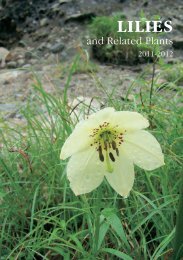LILIES - RHS Lily Group
LILIES - RHS Lily Group
LILIES - RHS Lily Group
Create successful ePaper yourself
Turn your PDF publications into a flip-book with our unique Google optimized e-Paper software.
Left, Lilium callosum has the widest<br />
distribution of any east Asian lily but is<br />
rarely seen in cultivation.<br />
and above, L. poilanei is a rare species<br />
from Vietnam.<br />
has produced no flowers yet. Lilium kelleyanum grew moderately well, since it<br />
seemed attacked by a virus, which resulted in deformed growth and flowers. But<br />
I am waiting to see if the same happens next year before throwing it away. Some<br />
other USA species also grow in the bed, such as Lilium parvum hallidayi and<br />
Lilium parryi from the lily group bulb auction. They seem to grow well, apart<br />
from some brown spots on the leaves. This might be a virus, but might have been<br />
formed by the inconsistent alternating warm and cold, sunny and rainy weather<br />
we had this spring and summer in Switzerland. The Lilium parryi bulbs planted in<br />
another bed in half shade, and covered by a fern seem to be doing much better.<br />
Lilium grayi did very well in its first year, flowering profusely but not reaching<br />
more than 60 cm. However it seems to be a lily which is very difficult to maintain,<br />
since it only produced one stem with one flower in its second year.<br />
Lilium kelloggii is a bit tricky. It rots very easily and did not seem to like<br />
65




